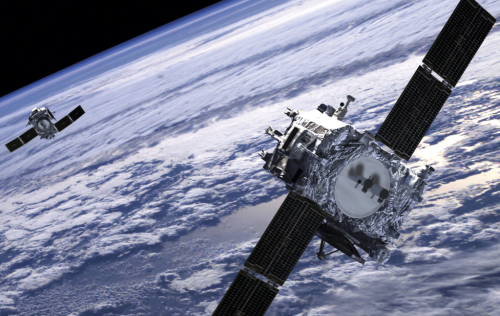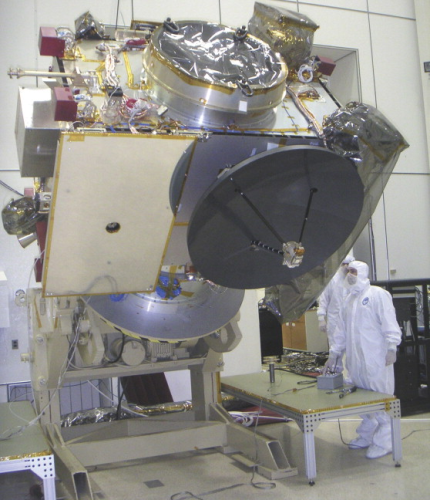

The two nearly identical spacecraft that make up NASA's Solar Terrestrial Relations Observatory (STEREO) gather images of the sun simultaneously from different angles. These are combined to produce three-dimensional pictures of coronal mass ejections that can knock out Earth-orbiting communications satellites and power grids on the surface of our planet.
STEREO observatories carry a number of mission-critical devices that must be thermally isolated from one another, as they orbit the sun. STEREO designers needed an insulating material that could withstand the stresses caused by launch, while maintaining adequate strength and insulation properties when exposed to the extreme temperatures of outer space.
A special glass epoxy composite developed specifically for cryogenic applications. To fit the bill, designers turned to a veteran of many space flights: a special glass epoxy composite developed specifically for cryogenic applications. The composite offers a unique combination of performance- and design-related features that made it an easy choice for the thermal isolation role on NASA's sun-watching spacecraft.
STEREO in space
Launched in 2006 aboard a Delta II rocket, the two STEREO observatories will soon be offset from one another as they sail through space. One will be positioned ‘ahead’ of the Earth in its orbit around the sun, while the other will be situated ‘behind’ the Earth. Just as the slight offset between a person's eyes provides depth perception, this placement will allow the STEREO observatories to obtain the first-ever three-dimensional images of the sun.
During their two-year mission, the STEREO observatories will provide a stream of stereoscopic images that will help scientists study the nature of coronal mass ejections (CMEs). These tremendous eruptions can blow up to 10 billion tons of the sun's atmosphere into space. Travelling away from the sun at speeds of approximately one million miles per hour, CMEs need only a few days to reach Earth, where they trigger severe magnetic storms that can cut off electric power and communications.
The STEREO observatories were designed and built for NASA by the Johns Hopkins University Applied Physics Laboratory (APL) in Laurel, Maryland, USA. Critical devices in the observatory design include ‘star trackers’ that use computers and star maps to determine the orientation and pointing accuracy of onboard instruments. To ensure that the spacecraft battery and other key devices work properly, APL protected them with thermal isolation that prevents the temperature of one device from affecting the controls of another. This protection takes the form of thermally isolating spacers that are placed between each device and the bracket holding it in place.
Like everything else on a spacecraft, the spacers are subjected to a variety of forces. The highest forces are applied during launch, when the spacecraft shakes violently as igniting rocket fuel lifts the craft off the ground and propels it up through Earth's atmosphere. In addition to vibration, launch can apply high shear, tensile, and compressive forces to spacecraft components, depending on their structure, orientation, and connections to other components.
Though not as severe as those caused by launch, other forces act on spacecraft components during their journey. As the craft travels through Earth's atmosphere, components are shaken by acoustic vibrations. And at all stages of the trip, components may experience thermal expansion/contraction and may be required to absorb impacts from flying objects.
Thumbs up for thermoset
To meet the thermal and structural require-ments of STEREO spacers, APL utilised a specialised epoxy resin and fibre glass reinforcement composite material. This thermoset composite provides excellent strength and thermal insulation. In addition, the composite is rated to absolute zero (-460°F), so it retains the properties needed to do its job even in the extreme cold of outer space. This distinguishes it from most thermoplastics, which retain relatively little strength at very low temperatures.
Ceramics can also provide the thermal isolation required to protect the devices aboard the STEREO observatories. But ceramics proved much more expensive than the glass epoxy composite chosen. In addition to its expense, brittle ceramics may fracture when subjected to intense vibration during launch. And if ceramics are able to survive the trip through Earth's atmosphere, the intense cold of outer space would make ceramic components even more brittle – and therefore even likelier to fracture on impact with a flying object.
Metals are certainly strong enough for the thermal isolation aboard the STEREO spacecraft. However, a metal component has to be five to ten times thicker than a glass epoxy composite component to provide comparable insulation. Thick and heavy metal insulation components would complicate the job of APL engineers, who must deal with space and weight constraints when designing spacecraft. By contrast, thin and light composite insulation components can be slipped into spacecraft where needed without causing significant design changes, while still meeting space and weight requirements. Much lighter than steel but just as strong, the glass epoxy composite features a high strength-to-weight ratio. Aluminium, another common alternative, is also more thermally conductive than composites, so aluminium insulation components have to be considerably thicker than those made of glass epoxy composite, again complicating space and weight requirements.
Besides taking up more valuable room in spacecraft, thick steel or aluminium insu-lation components would be more prone to vibrate than thin composite isolators. Aboard spacecraft, excessive vibration can lead to structural problems as rocket and payload climb through the atmosphere toward space.
The coldest environments
As the sun-watching STEREO observatories sail through space, key devices are thermally isolated from each other by spacers made of a special glass epoxy composite. Designed for cryogenic conditions like those encountered in outer space, this composite maintains sufficient strength and insulation properties even when temperatures plunge to absolute zero.
Compared to other materials that could be used in low-temperature applications, the composite offers excellent strength and durability, along with space and cost savings that make it an attractive option for dealing with the coldest environments in the universe.





